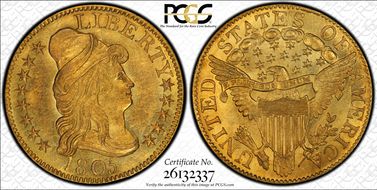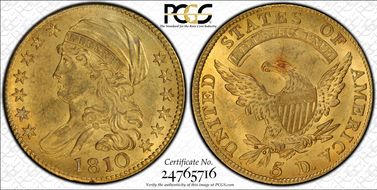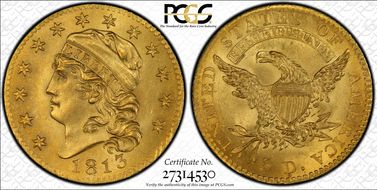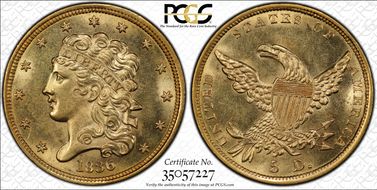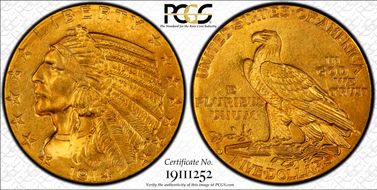Jesh 的钱币相册
CAC. Breen-6444, BD-3, High R.5. A moderate mintage of 33,183 Capped Bust Right half eagles was achieved in 1805, with five different die marriages known to collectors today. The coin offered here is an example of the rare BD-3 variety, characterized by the imperfect 1 in the date, star 1 distant from the bust, and star 9 close to Y in LIBERTY. John Dannreuther estimates an initial mintage of 2,000-3,000 pieces for BD-3, with a surviving population of 35-45 examples. The present coin is an attractive example, with noticeably prooflike fields. Heavy clash marks can be seen in the right reverse field, with some adjustment marks in the center obverse. Sharply struck, with exquisite detail on the central devices, and only slight weakness on the peripheral stars. A few scattered field marks prevent an even higher grade. Population (all varieties): 44 in 62, 58 finer (11/11).
CAC. Breen-6444, BD-3, High R.5. A moderate mintage of 33,183 Capped Bust Right half eagles was achieved in 1805, with five different die marriages known to collectors today. The coin offered here is an example of the rare BD-3 variety, characterized by the imperfect 1 in the date, star 1 distant from the bust, and star 9 close to Y in LIBERTY. John Dannreuther estimates an initial mintage of 2,000-3,000 pieces for BD-3, with a surviving population of 35-45 examples. The present coin is an attractive example, with noticeably prooflike fields. Heavy clash marks can be seen in the right reverse field, with some adjustment marks in the center obverse. Sharply struck, with exquisite detail on the central devices, and only slight weakness on the peripheral stars. A few scattered field marks prevent an even higher grade. Population (all varieties): 44 in 62, 58 finer (11/11).
CAC. Purchased as MS63/CAC. State c/b. Die clashing is seen most notably at the top of the obverse above the cap. This common early gold type coin has an estimated survival of 500 to 750 pieces, out of an a total of 75,000 to 90,000 originally minted. Of course, the vast majority of those produced were melted from the date of issue through 1834, at which time gold coins became worth less than their intrinsic value. This is a lovely orange-gold example whose color is only interrupted by a spot of copper (from improper mixture of the gold/copper alloy in that area) over the eagle's eye. The devices are sharply struck throughout, and there are no obvious or detracting abrasions. (Upgrade from MS63) EX: Oliver Collection PCGS 1/35 (05/15)
CAC. Purchased as MS63/CAC. State c/b. Die clashing is seen most notably at the top of the obverse above the cap. This common early gold type coin has an estimated survival of 500 to 750 pieces, out of an a total of 75,000 to 90,000 originally minted. Of course, the vast majority of those produced were melted from the date of issue through 1834, at which time gold coins became worth less than their intrinsic value. This is a lovely orange-gold example whose color is only interrupted by a spot of copper (from improper mixture of the gold/copper alloy in that area) over the eagle's eye. The devices are sharply struck throughout, and there are no obvious or detracting abrasions. (Upgrade from MS63) EX: Oliver Collection PCGS 1/35 (05/15)
CAC. BD-1, R.2. Bass-Dannreuther Die State b/b. The Capped Bust Left design was modified in 1813, with the bust and eagle restyled and the stars arranged in a continuous arc above the portrait, instead of the 7x6 arrangement of the previous design. A substantial mintage of 95,428 pieces was achieved, with only two die varieties known for the date. This coin represents the more available BD-1 variety, identified by the position of the first S in STATES over the right side of E in PLURIBUS. The BD-1 is the only readily available date and variety of this design type, making it a favorite choice of type collectors. The BD-1 probably accounted for 60,000-75,000 pieces of the reported mintage, with a surviving population of 450-650 examples in all grades. John Reich's secret signature star punch, with the notched outside point, was used on star 13. The obverse die was also used to strike the BD-2 variety of this date, but the BD-1 is the only use of the reverse die. As a date, 1813 half eagles have been avidly collected since the 1850s, with an example appearing in lot 187 of the A.C. Kline Sale (Moses Thomas & Sons, 6/1855). More recent sales include the appearance of the present coin in lot 5093 of the FUN Signature (Heritage, 1/2011), which realized $48,875. The coin offered here is a spectacular near-Gem example, with pleasing yellow-gold surfaces and strong rose highlights at the peripheries. The design elements are sharply detailed, and vibrant mint luster beams on both sides. A few light adjustment marks appear on Liberty's cheek on close inspection, but they have little impact on the coin's extraordinary visual appeal. Population: 48 in 64, 3 finer (6/12). 48/4 (1/14)
CAC. PCGS Secure. The 1914-D half eagle, with a mintage of 247,000 coins, is a rare issue in higher grades, as the population data reveals. This highly lustrous and frosty example has brilliant honey-gold luster with pristine surfaces. Only two 1914s of any grade have received a Plus designation. Population: 2 in 64+, 14 finer (7/10).
CAC. PCGS Secure. The 1914-D half eagle, with a mintage of 247,000 coins, is a rare issue in higher grades, as the population data reveals. This highly lustrous and frosty example has brilliant honey-gold luster with pristine surfaces. Only two 1914s of any grade have received a Plus designation. Population: 2 in 64+, 14 finer (7/10).




















